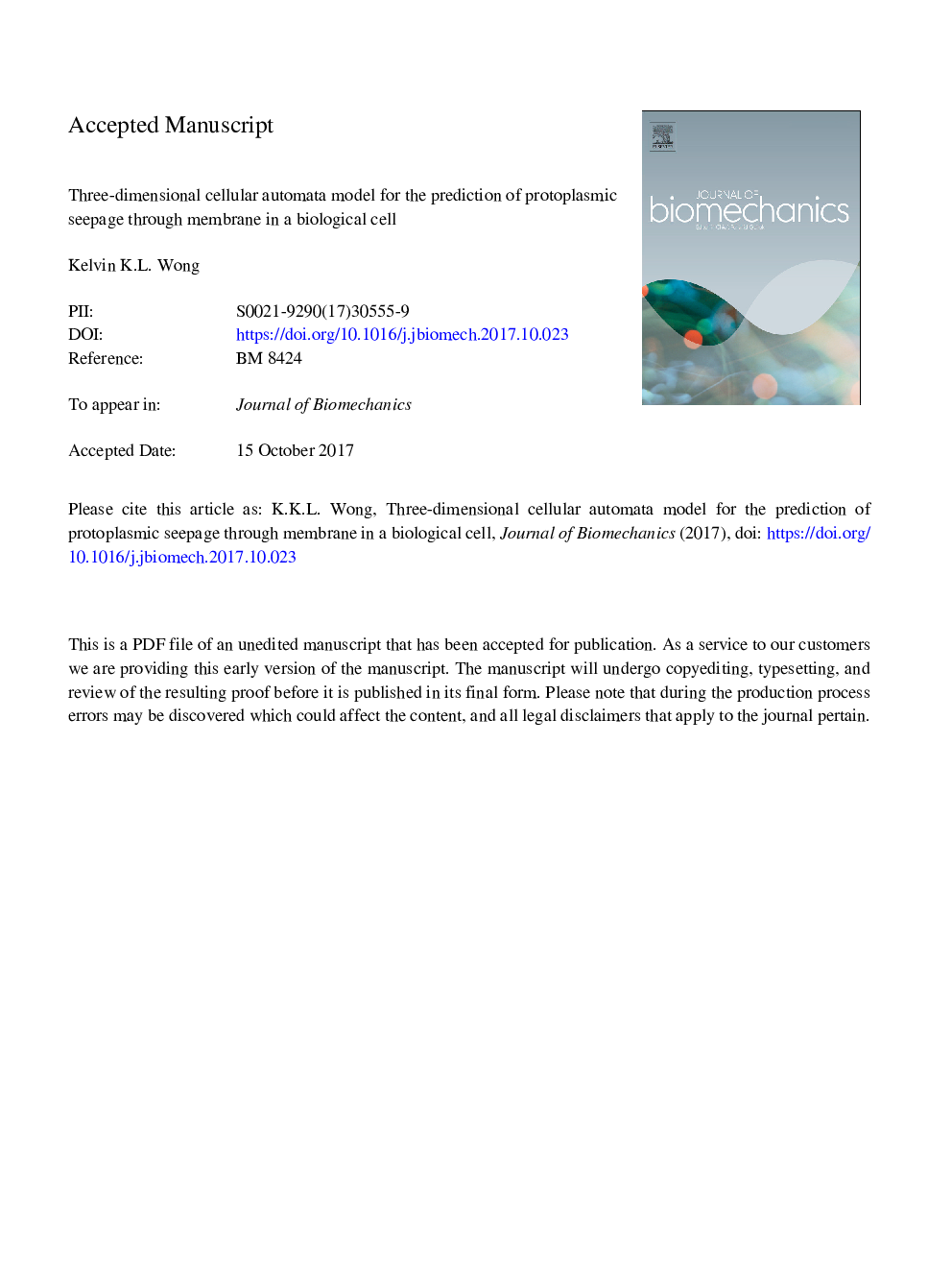| کد مقاله | کد نشریه | سال انتشار | مقاله انگلیسی | نسخه تمام متن |
|---|---|---|---|---|
| 7237017 | 1471099 | 2017 | 37 صفحه PDF | دانلود رایگان |
عنوان انگلیسی مقاله ISI
Three-dimensional discrete element method for the prediction of protoplasmic seepage through membrane in a biological cell
ترجمه فارسی عنوان
یک روش عنصر گسسته سه بعدی برای پیش بینی نفوذ پروتئین از طریق غشاء در یک سلول بیولوژیکی
دانلود مقاله + سفارش ترجمه
دانلود مقاله ISI انگلیسی
رایگان برای ایرانیان
کلمات کلیدی
مدل سازی سلول، روش عنصر گسسته، اشباع پروتوپلاسمیک، سلول بیولوژیک، هسته،
ترجمه چکیده
این مقاله یک مدل سلولی بیولوژیکی سه بعدی و فشرده را بر اساس المان های گسسته ارائه می دهد که با استفاده از عامل های مختلف در تعامل که ساختارهای سلولی را در یک محیط شبیه سازی شده نشان می دهد. رفتار سیتوپلاسم و مایع نوکلئوپلاسمی در سلول وابسته به زمان است. هنگام استفاده از این رویکرد، مهم است که رفتارهای جریان پروتئین پلاسما را از طریق تکنیک های شبیه سازی مانند فشرده سازی سلول و بررسی عوامل مؤثر بر سلول های سیتوپلاسمی که بین غشاهای سلولی محصور می شوند، کالیبراسیون کنند. این نوع مدل سازی ممکن است کار آینده را در شبیه سازی عملیات همزمان و تعاملات عوامل متعدد سلولی در تلاش برای دوباره ایجاد و پیش بینی ظهور پدیده های پیچیده مانند نفوذ پاتولوژیک که توسط نیروی اعمال سلول های همسایه ایجاد می شود، ایجاد کند. شخم زدن زمانی اتفاق می افتد که یک عامل سیتوپلاسم بین سه ذره غشاء متصل در شبکه مثلثی عبور می کند. بر اساس پاسخ نیروی - تغییر شکل در حوزه های دارای اندازه متغیر و سختی، عبارات نیمه تحلیلی برای نیروی مورد نیاز برای ایجاد نفوذ و حل عددی برای پیدا کردن حداکثر مقاومت ارائه شده توسط غشا در برابر نفوذ سیتوپلاسمی توسعه یافته است. معادلات بر اساس تعادل نیروی و روابط سازنده برای تماس با ذرات و سختی غشا است. در نمایهای چند ذره از یک سلول فردی تحت تغییر شکل، حالت های مختلف سیتوپلاسم از طریق محدود کردن غشاهای سلولی می تواند رخ دهد. این را می توان در صورتی که معیارهای ساده رضایت داشته باشند اجتناب شود. این یافته ها می تواند به قوانین اساسی خاصی برای بهبود روش های جدید شبیه سازی سلولی به عضو بر اساس المان گسسته منجر شود.
موضوعات مرتبط
مهندسی و علوم پایه
سایر رشته های مهندسی
مهندسی پزشکی
چکیده انگلیسی
This paper presents a three-dimensional and compressible biological cell model based on discrete element method using multiple interacting agent that represent cellular structures within a simulated environment. The cytoplasm and nucleoplasm fluid behavior in the cell is time dependent. When taking this approach, it is important to calibrate protoplasmic flow behaviors through simulation techniques such as compressing the cell and examining the agents representing the cell cytoplasm seeping between the ones representing the confining cell membrane. This type of modelling may motivate future work on simulating simultaneous operations and interactions of multiple cellular agents in an attempt to re-create and predict the appearance of complex phenomena such as protoplasmic seepage that is caused by the force actuations of neighboring cells. Seepage occurs when a cytoplasm agent passes between three membrane particles connected in a triangular network. Based on the force-deformation response of spheres having variable size and stiffness, semi-analytic expressions are developed for the force required to cause seepage and solved numerically to find the maximum resistance offered by the membrane against cytoplasm seepage. The equations are based on force equilibrium and the constitutive relations for particle contact and membrane stiffness. In multi-particle representations of an individual cell undergoing deformation, different modes of cytoplasm seepage through confining cell membranes can occur. This can be avoided if simple criteria are satisfied. These findings can lead to certain fundamental laws for the improvement of novel cell-to-organ simulation techniques based on discrete element method.
ناشر
Database: Elsevier - ScienceDirect (ساینس دایرکت)
Journal: Journal of Biomechanics - Volume 65, 8 December 2017, Pages 115-124
Journal: Journal of Biomechanics - Volume 65, 8 December 2017, Pages 115-124
نویسندگان
Kelvin K.L. Wong,
